Bay leaves are all Mediterranean. They can add flavor and aroma to every dish and are quite nutritious as well, so every chef or home cook likes to have them at hand when he is planning to produce a culinary masterpiece.
But what happens when you run out of or can’t find bay leaves at your local grocery store? You don’t have to worry too much because I’ve got you covered with a list of amazing bay leaf substitutes.
So, get ready to spice up your cooking game and discover new flavors that will leave your taste buds begging for more.
1. Thyme

Maybe it doesn’t sound like a great alternative at first if you know how it looks (it looks entirely different from bay leaf), but the minty flavor it has, makes it one of the best bay leaf substitutes.
Pros:
• The biggest advantage of using thyme as a substitute for bay leaf is the fact that it can provide your dish with a similar earthy and slightly sweet flavor with hints of mint.
• Thyme also has a pleasant aroma that can enrich the overall flavor experience of the dish; its aroma can be described as herbaceous, earthy, and slightly sweet.
• Thyme leaves are widely available at most grocery stores.
Cons:
• Thyme has a quite strong flavor that can easily overpower other ingredients in your dish if you are not careful.
• Thyme and bay leaves have entirely different appearances, so it is not an ideal substitute if you are planning to use it as a garnish.
How To Use It As A Substitute:
Like bay leaves, you can use fresh or dried thyme, but you can also use thyme sprigs.
Since dried thyme is more available and less expensive, it is mostly used in recipes. However, you have to be aware of the fact that it has a more concentrated flavor, so you should use it in moderation.
It is best to start with a ¼ teaspoon of dried thyme and add more if you think that it is not strong enough.
You can use thyme in soups, stews, and casseroles but, honestly, you will get the best out of it if you use it as seasoning for meats and poultry.
2. Basil
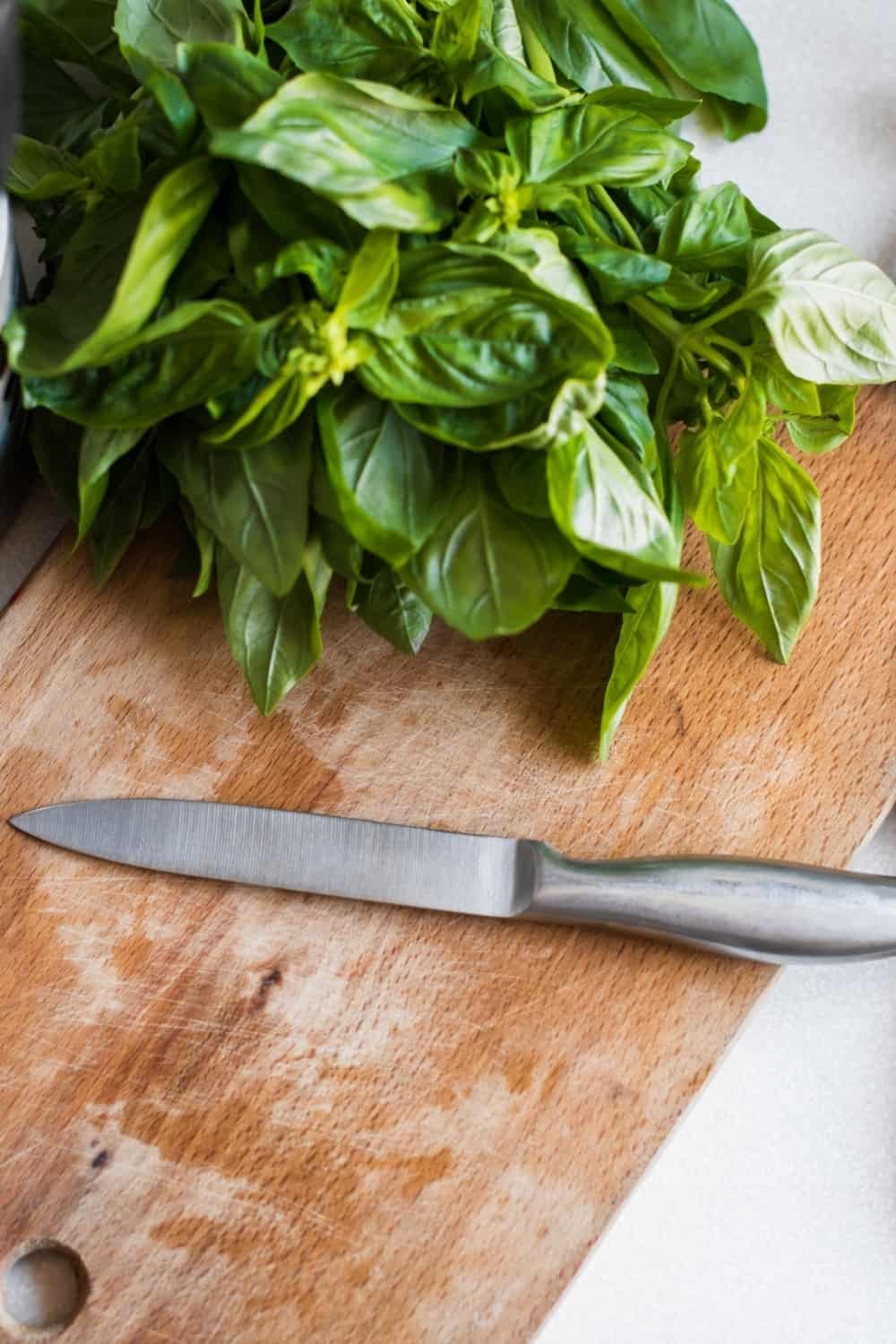
Basil is a staple of Italian cuisine and it makes many dishes more flavorful and aromatic. It can therefore be used as a substitute for our food that starts with b, but not in all dishes.
Pros:
• Although it doesn’t have the same flavor profile as bay leaves, basil has a combo of sweet and slightly peppery flavors that can complement many dishes perfectly.
• Just like bay leaves, it also has a pleasant aroma that can enhance the flavor profile of your dish.
• Finally, it is a more available herb, i.e. it can be found in most grocery stores as well as gardens.
Cons:
• Basil leaf has a much stronger flavor than bay leaf, so it can easily overpower other ingredients in your dish.
• Although it can be used as a good substitute for bay leaf, its usage is quite limited to Italian dishes, especially tomato-based dishes and beef.
How To Use It As A Substitute:
Basil leaves have a sweet flavor, so it is a perfect option for some dishes of Italian origin, especially tomato-based dishes and those that incorporate beef.
It is best to use whole basil leaves, but you can also chop them and add them to your dish.
Dried basil leaves can be used as a seasoning, but you have to consider that they are more concentrated in flavor, so you will probably have to experiment with the amount you use.
The general rule of thumb is to use a 1:1 ratio, especially if you are dealing with whole fresh basil leaves. Take note that 4-8 fresh basil leaves equal 1 teaspoon of dried basil.
Whole basil leaves are at their best in soups, stews, and tomato sauces, while you can also use chopped basil leaves as a seasoning for pasta sauces, salads, and marinades. You can also use it to top slices of bread for your ideal Spuntini.
3. Mexican Oregano
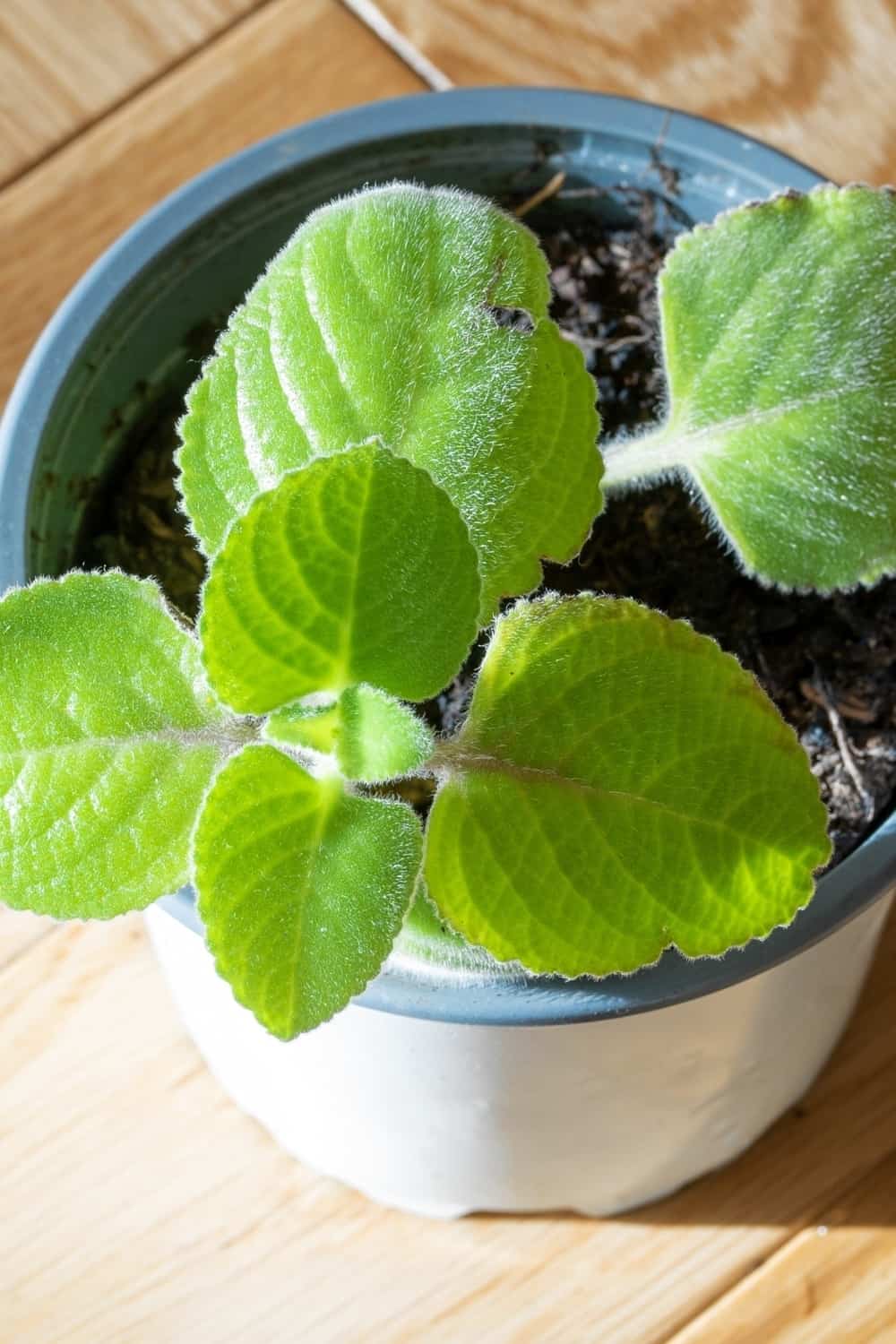
Also known as Mexican marjoram or Mexican wild sage, Mexican oregano is a very popular seasoning in Mexican, Tex-Mex, and Latin American cuisine. Although it is not a perfect alternative, it can be decently served in some dishes, especially Mexican ones.
Pros:
• Mexican oregano has a unique flavor profile that is a combination of strong, pungent, and citrusy flavors that can add a unique taste to many types of dishes.
• It is readily available at most grocery stores and can be found in many online spice shops.
• Mexican oregano is quite healthy, i.e. it is low in calories and high in antioxidants, which can protect the body from damage caused by free radicals.
Cons:
• Mexican oregano has a very distinct flavor from bay leaves.
• Mexican oregano is not so versatile when it comes to substituting bay leaves since it is mostly used in Mexican and Tex-Mex cuisine.
How To Use It As A Substitute:
The first thing you have to consider when substituting is that Mexican oregano has a different flavor profile and its taste is stronger than that of bay leaves.
Because of that, you will have to use it in smaller amounts. It is best to use ¼ teaspoon of Mexican oregano to replace 1 bay leaf.
It is not out of hand to crush it slightly to release its oils before adding it to the recipe.
You can add it at the same time you would add the bay leaf in the recipe, but it stays there till the end, which is not the case with bay leaf that must be removed from the dish before serving.
This substitution will do wonders for your chili, salsa, beans, and meat dishes that are being cooked in a Latin or Mexican style.
4. Boldo Leaves
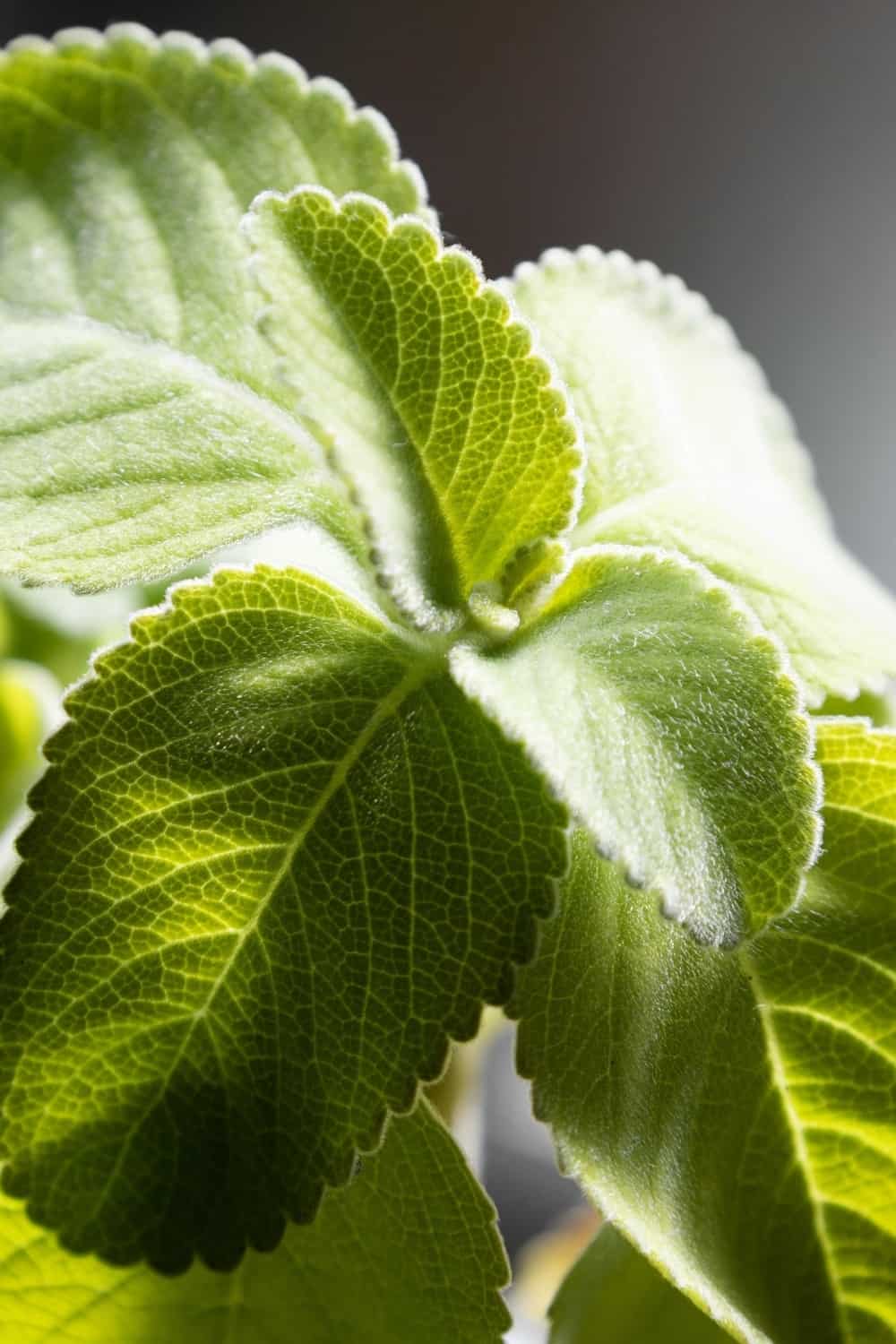
A type of herb that comes from the Peumus boldus tree which is native to South Africa, boldo leaves are mostly used as a flavor enhancer in Chilean dishes. In recent years, many people from other cuisines are starting to use it as a bay leaf substitute.
Pros:
• Similar to bay leaves, boldo leaves have a pungent, bitter flavor that can add depth to many types of dishes.
• If the health food store is close to your home, you will certainly find these leaves there, and you can also find them online.
• Boldo leaves had been used in traditional Chilean medicine for many years due to their high levels of antioxidants; according to research if consumed in moderation, boldo leaves can also be beneficial for liver health. (1)
Cons:
• These leaves are much stronger in flavor than bay leaves and they can easily overwhelm other ingredients in your dish.
• Although they can enrich the overall flavor profile of your dish, their flavor is quite distinct from that of bay leaves, which could alter the overall taste of your dish significantly.
• Research suggests that consuming boldo leaves in higher amounts on a regular basis, can cause hepatotoxicity. (2)
How To Use It As A Substitute:
The most important thing you have to consider is that boldo leaves have a very intense flavor, so you should use them in moderation.
For the best flavor, my recommendation is to use half of the amount required for bay leaves from the recipe.
Do not overdo it because, despite the fact that it will ruin the taste of your dish, alkaloids from the leaves can be toxic in high doses.
It is best to add boldo leaves at the beginning of the cooking process so that the flavor has time to infuse the dish.
If you think that the flavor is too strong, you can dilute it by adding more liquid or other seasonings.
You can use boldo leaves in soups, stews, marinades for beef and lamb, roasted meats, and various rice dishes, including risotto and one of the most eaten dishes in the world known as paella.
5. Juniper Berries
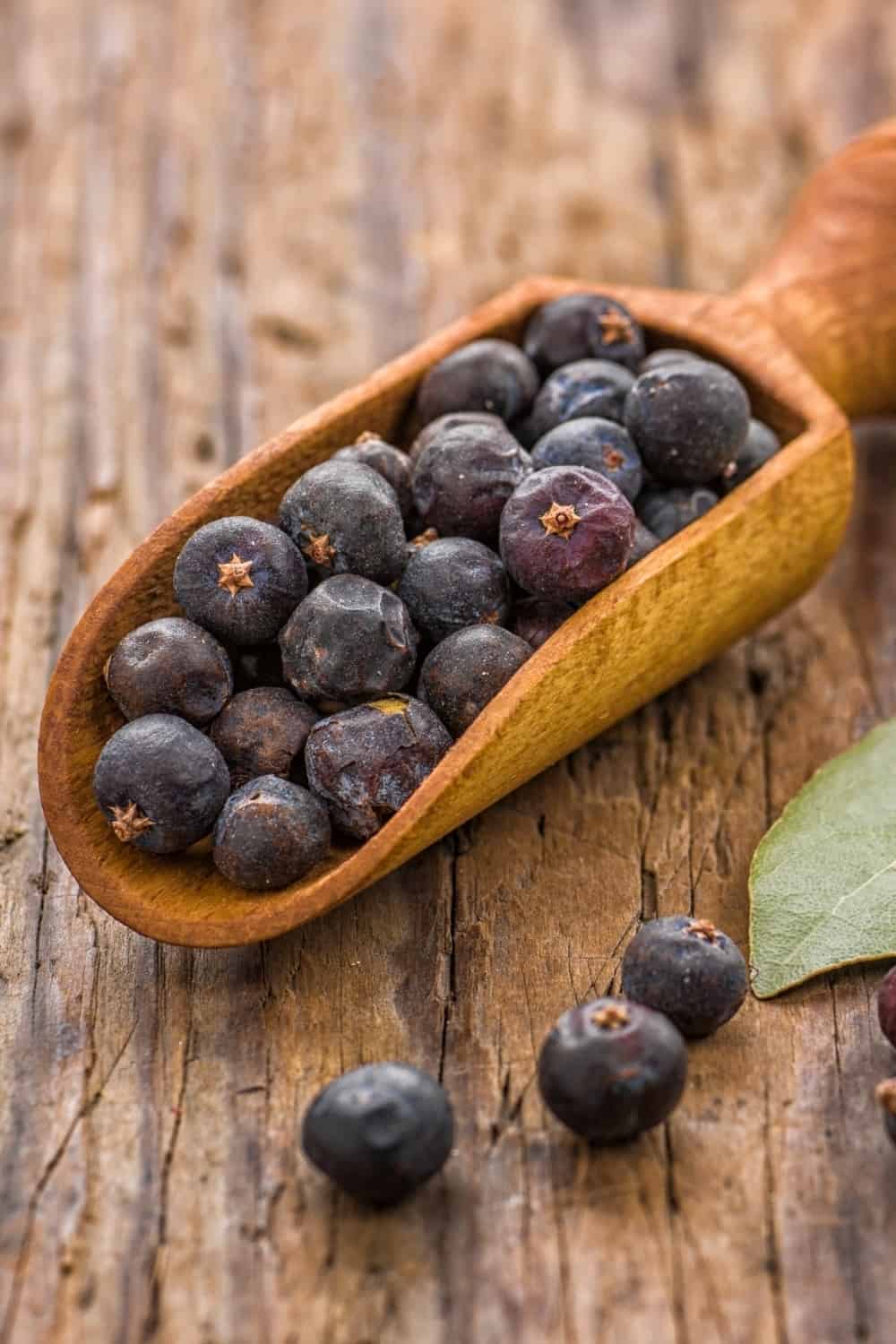
They are one of the main ingredients in popular alcoholic beverages (gin), have been used for many years for medical purposes, and are popular ingredients in Eastern European cuisine. Juniper berries can also be a decent bay leaf alternative.
Pros:
• Juniper berries can add a similar depth in flavor to your dish because they also have a pungent, resinous flavor.
• Juniper berries can be found at many specialty stores and online.
• They are also quite healthy since they are full of antioxidant and anti-inflammatory compounds.
Cons:
• Juniper berries are stronger in flavor than bay leaves which can negatively affect some of your dishes.
• They have a unique flavor that is not suitable for all types of dishes that require bay leaves.
• Not everyone is allowed to consume these berries since they can be harmful to young children and pregnant women.
How To Use It As A Substitute:
Juniper berries have a much stronger flavor than bay leaves, so it is important to use them in moderation.
As a general rule, use ¼ teaspoon per bay leaf that the recipe calls for.
Before adding them to the dish, you can crush them to release their flavor.
Also consider pairing them with other herbs and spices, including thyme, rosemary, or sage, to enhance their flavor.
Finally, it is best to use juniper berries in savory dishes, particularly those with rich, bold flavors such as stews, casseroles, and roasts.
6. Rosemary
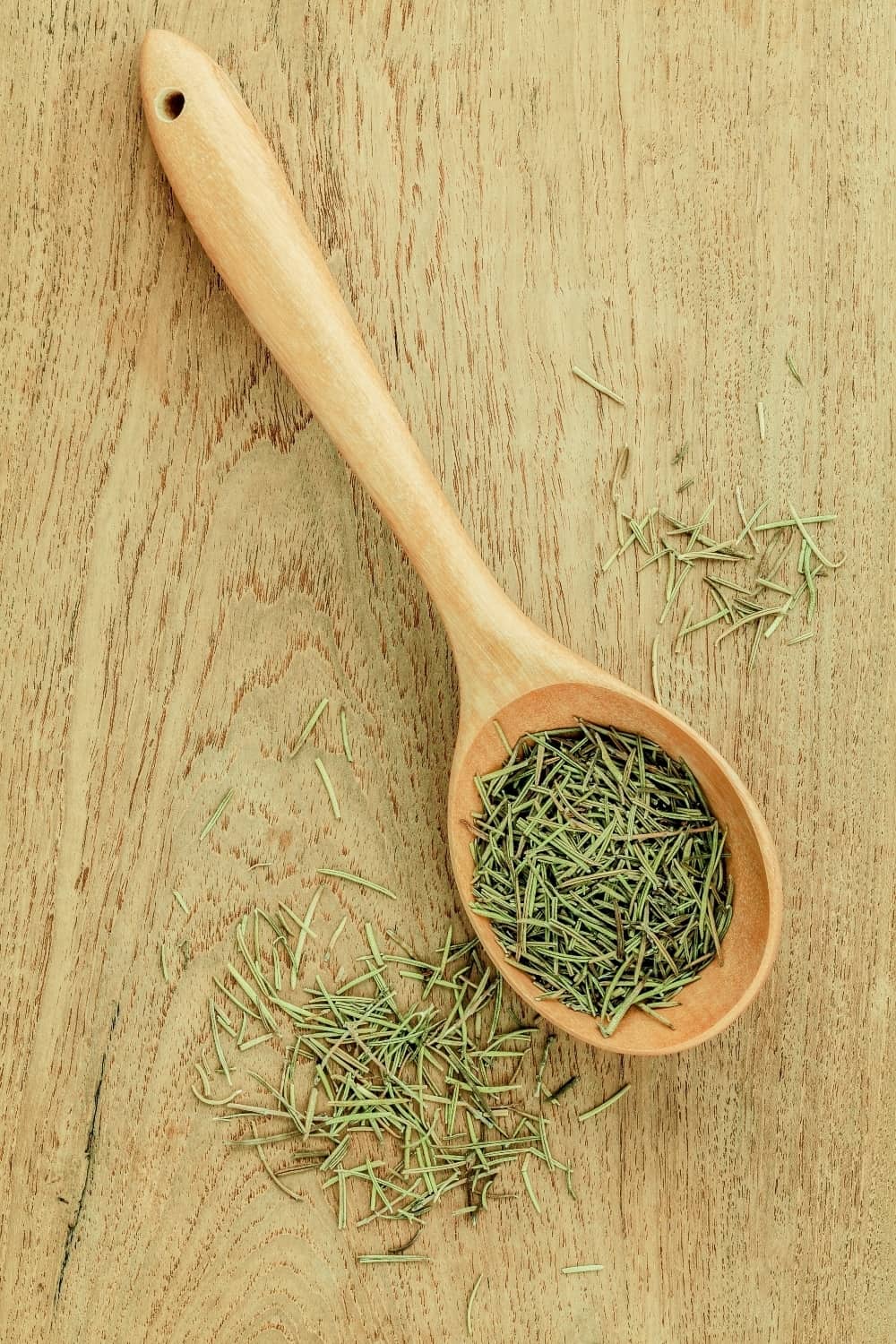
Rosemary is one of the most popular ingredients in various types of dishes, so it is no surprise that it found its place on this list, although it doesn’t have the same flavor as bay leaves. However, it can serve as a decent alternative in some dishes.
Pros:
• Rosemary has an earthy, herbal flavor that can add depth and complexity to many different dishes.
• It is widely available at grocery stores and it is commonly found on the shelves of many kitchens.
• Rosemary is full of antioxidants and anti-inflammatory compounds that can be very beneficial for your overall health.
Cons:
• It has a stronger flavor than bay leaves that can easily overpower your dish.
• Its flavor profile is not exactly the same as that of bay leaves, so it can not be used in all types of dishes as a substitute.
How To Use It As A Substitute:
The most important thing to consider when using rosemary as a substitute is to use it in moderation because it has a stronger flavor than bay leaves.
In general, it is best to use ¼ teaspoon of dried rosemary for every bay leaf to achieve a similar level of flavor.
If you have any, you can also use fresh rosemary, but you will have to add even less because it has a stronger flavor than the dried version.
Before adding it to your dish, pair it with complementary flavors. Rosemary pairs well with other savory and herbal flavors that come from thyme, oregano, and sage.
Use it as a bay leaf substitute with steaks, roasts, fish, lamb, mutton, goat, pork, and other gamey meats. Rosemary also works great in potato dishes, as well as sauces, soups, and stews.
See Also: 16 Best Substitutes For Rosemary To Imitate Its Unique Flavor
7. Red Bay Leaves
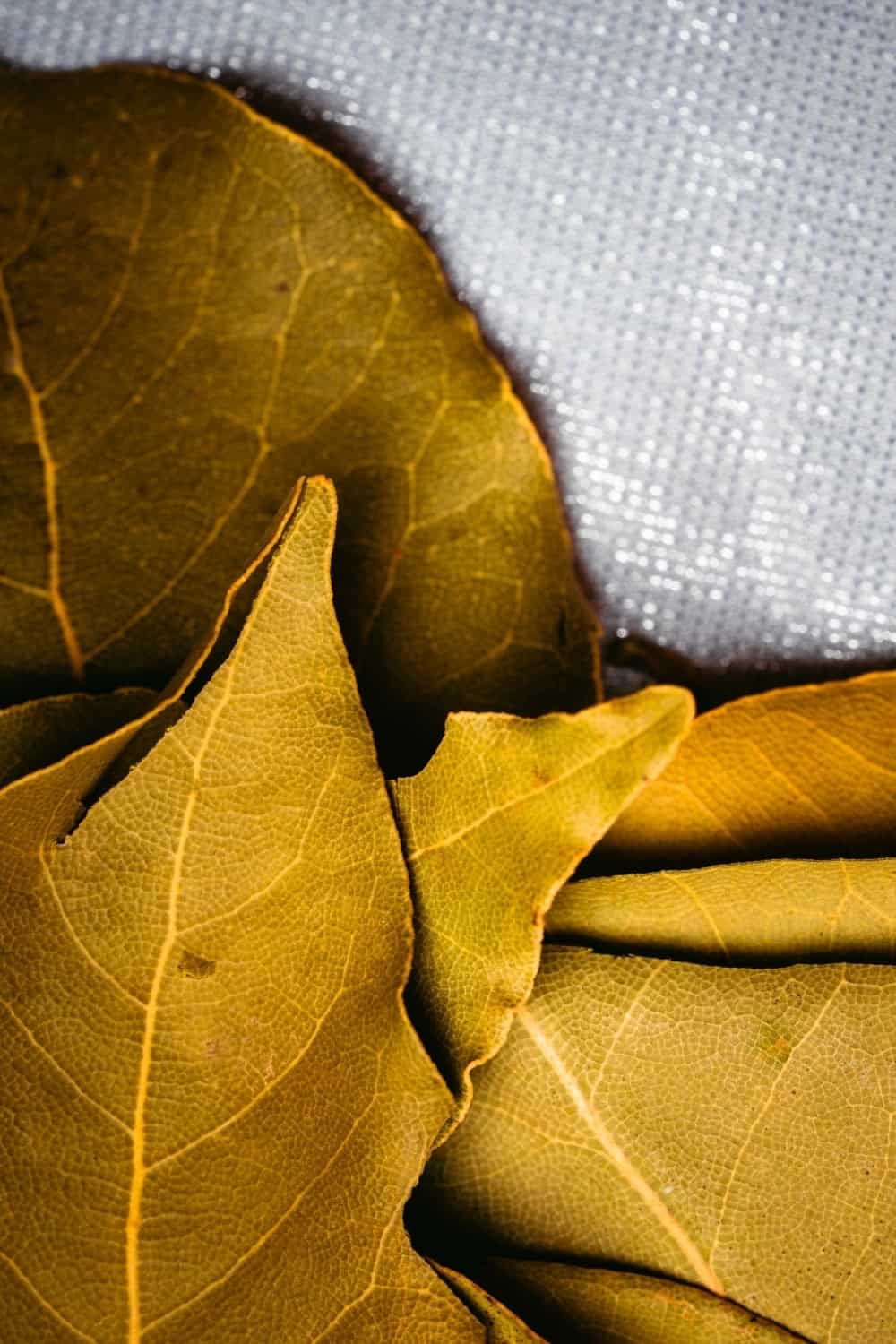
The name might trick you at first, but red bay leaves are actually not red but green. They come from an entirely different tree known as the red bay tree (Persea borbonia). However, they can be a good substitute to some extent.
Pros:
• They have a similar appearance to bay leaves, which can make them a suitable substitute in terms of appearance.
• Red bay leaves are mainly used for medicinal purposes due to their antioxidant and anti-inflammatory properties.
Cons:
• Red bay leaves have a different flavor profile and may not provide the same depth and complexity of flavor to your dish.
• They are not as commonly used as in cuisine, so it may be more difficult to find them at ordinary grocery stores.
How To Use It As A Substitute:
Red bay leaves are a bit milder in flavor than bay leaves, so you may need to use more of them to get the desired taste.
It is best that you use 2-3 dried red bay leaves for every fresh bay leaf.
However, take note that red bay leaves have a different flavor that can affect the final flavor profile of your dish.
When your dish is ready, it is important to remove the red bay leaves before serving, as they can be tough and leathery.
You can use red bay leaves in any recipe that calls for bay leaves, such as soups, stews, and casseroles.
8. Curry Leaves
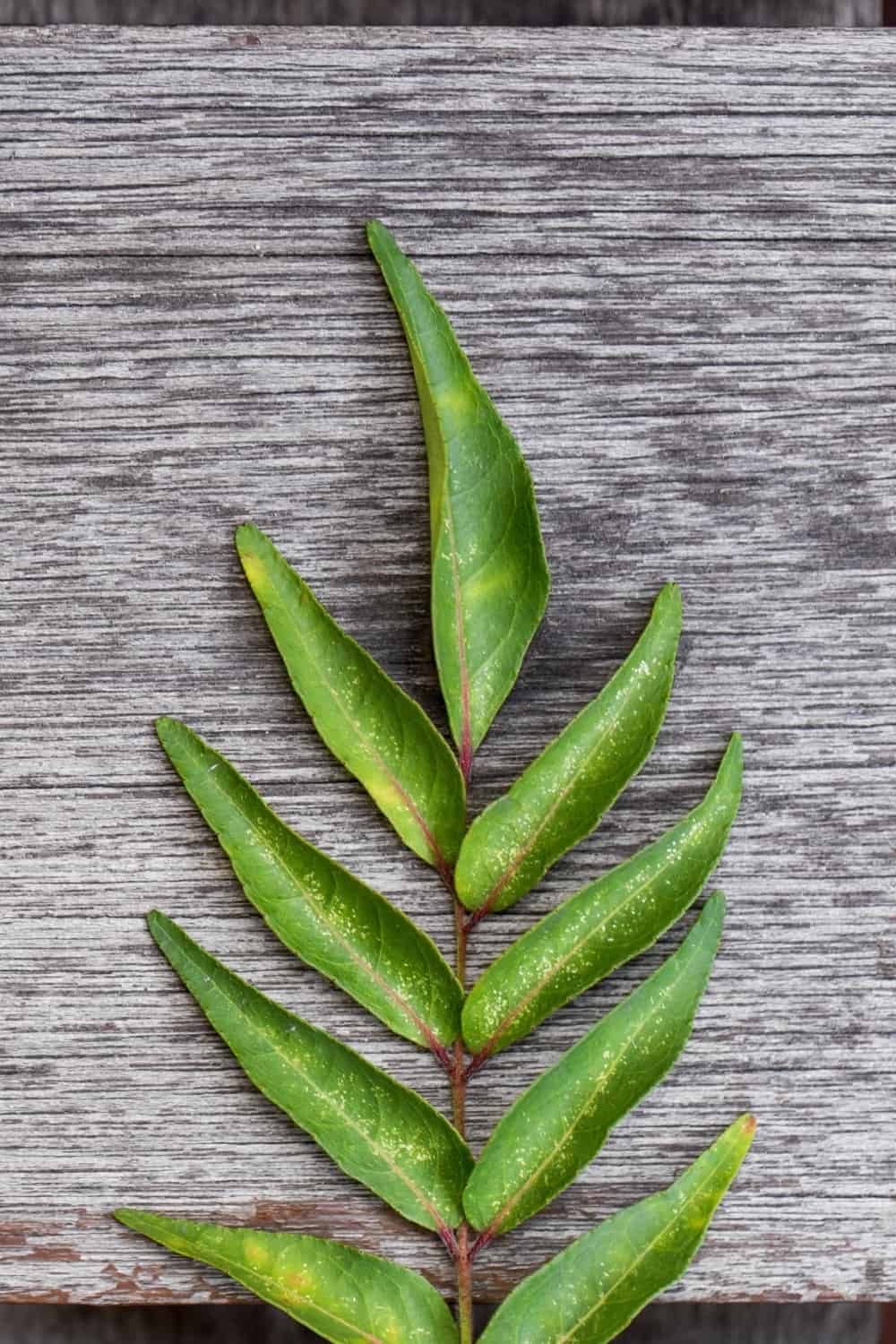
Bay leaves are sometimes referred to as Mediterranean curry leaves, so it is no surprise that they are on this list. Their flavor profiles are not exactly the same and curry leaves are mostly used in Indian cuisine, but they can make a decent sub.
Pros:
• Curry leaves have a unique flavor profile that can add complexity and depth to almost any type of dish, especially one that comes from Indian or Southeast Asian cuisine.
• Curry leaves are also considered aromatic herbs since they can enrich every dish with their lemon scent.
• According to a study, curry leaves can produce antioxidant, antidiabetic, anti-inflammatory, antitumor, and neuroprotective activities in your body which can be very beneficial for your overall health. (3)
Cons:
• Curry leaves have a stronger flavor than bay leaves, so they can easily overpower other ingredients.
• Curry leaves do not have the same flavor profile as bay leaves as they are more citrusy in flavor, which can affect the overall flavor profile of your dish.
• Although they can be found at most stores, it is generally more difficult to find curry leaves than bay leaves.
How To Use It As A Substitute:
Because they have a stronger flavor that is distinct from the flavor of bay leaves, it is important to use curry leaves in moderation.
Curry leaves are smaller than bay leaves, so you can use 1 curry leaf for 1 bay leaf, but nothing more than that.
When adding them to your dish, it is best to add them at the beginning of the cooking process, but you should remove them from the dish before serving because they tend to become tough and leathery.
It is best to use curry leaves in Indian or Southeast Asian dishes, including soups, curries, and dals.
See Also: 10 Curry Leaves Substitutes To Solve Your Leaf Shortage
9. Marjoram
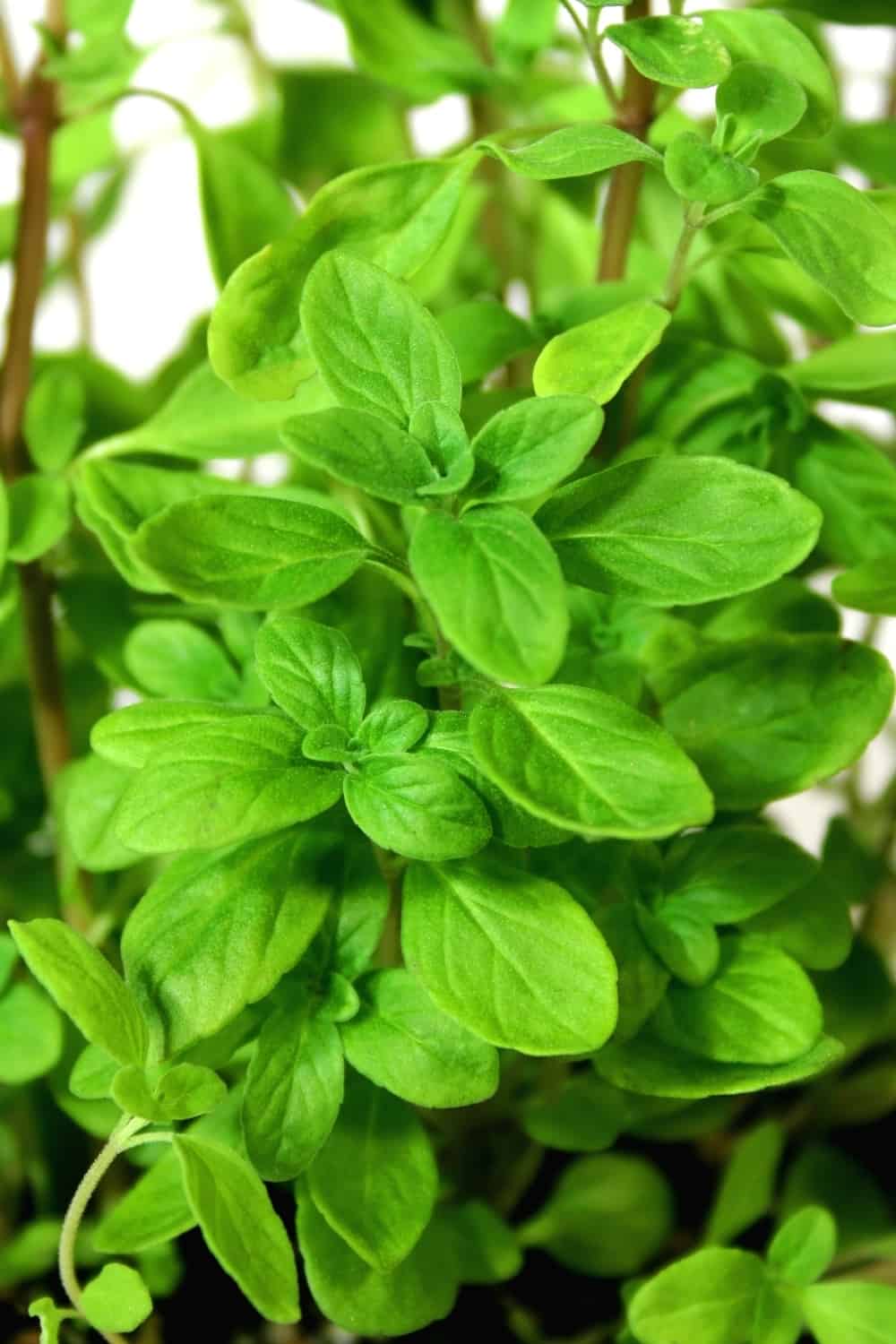
This member of the mint family (alongside lemon balm and mint) which has a combination of sweet and citrusy flavors is one of the most popular herbs used in Mediterranean and Middle Eastern cuisine. It isn’t an ideal substitute for bay leaf, but it has its advantages.
Pros:
• With its citrusy flavor and slightly sweet undertones, marjoram can complement a wide range of dishes.
• Marjoram is highly available at many grocery stores and can be found fresh or dried.
• It is also very healthy since it contains many anti-inflammatory and antibacterial properties.
Cons:
• Marjoram is milder in flavor, so it may not work well in some dishes that require bay leaves.
• It also has a different flavor profile than bay leaves, so using it as a substitute can alter the flavor of a recipe.
• It is highly available, but it is much more expensive than bay leaves.
How To Use It As A Substitute:
Since it is milder than bay leaves, you should add a bit more to the recipe. But not too much because you will alter the flavor profile of your dish.
My recommendation is to add ½ to 1 teaspoon of dried marjoram in place of one bay leaf. If you are using a fresh version, add double the amount as you would use dried marjoram because it is milder.
For the best result, add the marjoram at the beginning of the cooking process so that it has time to release its flavor.
Use it in soups, stews, sauces, and braises. You can also use it to flavor roasted vegetables and grilled meats.
10. Sage
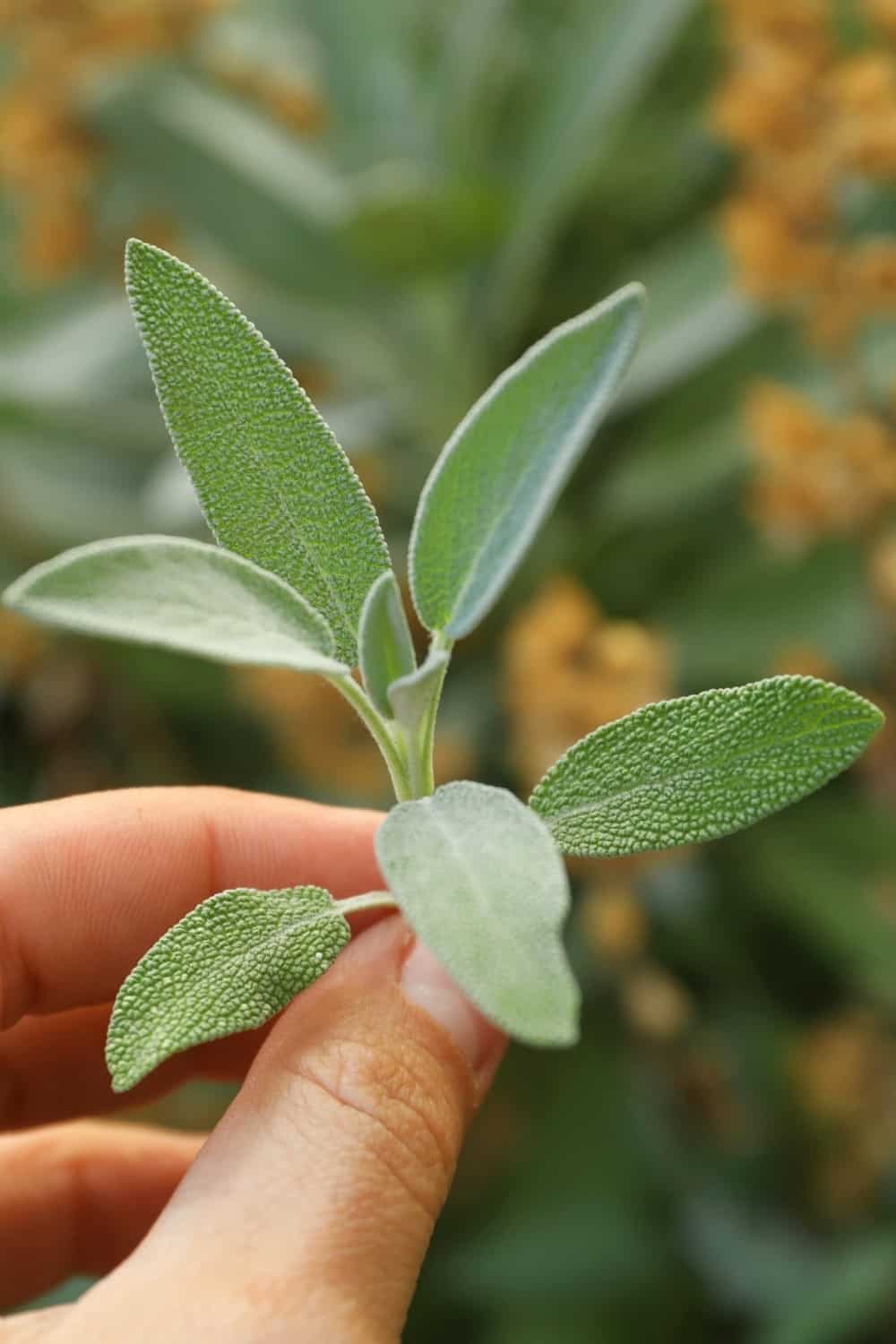
This perennial herb, just like marjoram, is mostly used in Mediterranean and Middle Eastern cuisine and it is becoming popular in many other cuisines as well. It can be used as a substitute if you are out of options, but it’s far from ideal.
Pros:
• Sage is readily available at many grocery stores and can be found fresh and dried, making it a convenient substitute if you don’t have bay leaves on hand.
• It is also very healthy due to its strong anti-inflammatory and antibacterial properties.
Cons:
• Sage has a much stronger flavor than bay leaves.
• It also has a different flavor profile, so using it as a substitute can alter the flavor of the recipe.
• Sage is also more expensive than bay leaves.
How To Use It As A Substitute:
First, you have to consider that sage has a much stronger flavor than bay leaves, so you should use it in lower amounts in a dish that requires bay leaves.
My recommendation is to use half as much sage as you would bay leaves.
This is also important due to the fact that it has a distinct flavor profile from that of bay leaves.
The good thing is the fact that you can use it fresh, dry, or ground into a powder.
Add fresh sage in salads or use it as a garnish; you should use dry sage leaves in cooked dishes; ground sage is often used in seasoning rubs or spice blends.
See Also: 8 Unique Chinese Five Spice Substitutes You Need To Try
Sources:
1. J Fernández, P Lagos, P Rivera, E Zamorano-Ponce. Effect of boldo (Peumus boldus Molina) infusion on lipoperoxidation induced by cisplatin in mice liver. 2009 Jul;23(7):1024-7. doi: 10.1002/ptr.2746.
2. Ricardo J Ribeiro, Carina Silvestre, Cristina Duarte. Hidden Risks of Alternative Medicines: A Case of Boldo-Induced Hepatotoxicity. 2017 Mar 4;14(2):186-190. doi: 10.1080/19390211.2016.1207123. Epub 2016 Aug 30.
3. Rengasamy Balakrishnan, Dhanraj Vijayraja, Song-Hee Jo, Palanivel Ganesan, In Su-Kim, and Dong-Kug Choi. Medicinal Profile, Phytochemistry, and Pharmacological Activities of Murraya koenigii and Its Primary Bioactive Compounds. 2020 Feb; 9(2): 101. Published online 2020 Jan 24.


